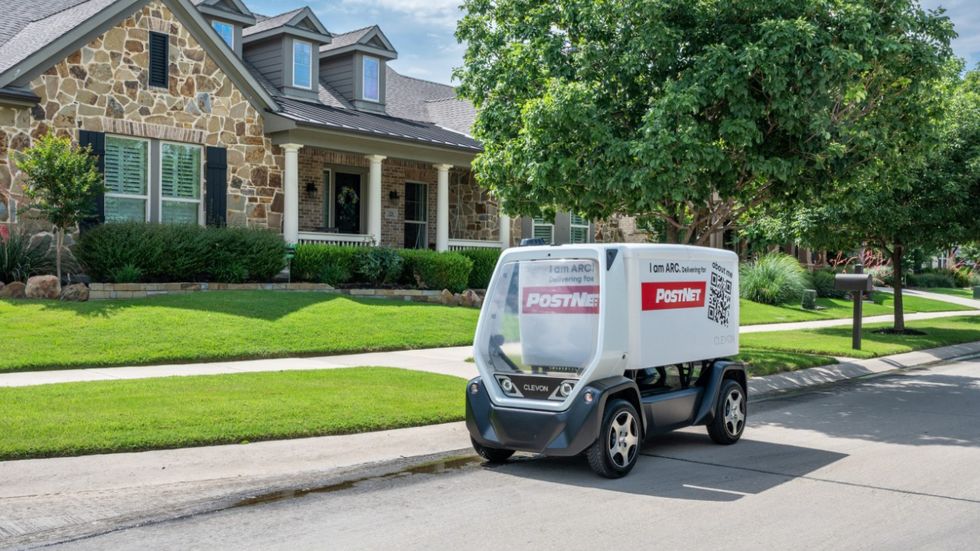- Estonian startup Clevon has launched parcel delivery and pickup operations in the US, starting in a suburb of two major cities, in the AllianceTexas Mobility Innovation Zone (MIZ).
- The company’s ARC delivery robot uses city streets like a car, working as part of Texas shipping company PostNet.
- Several startups, including Nuro AI, are making efforts to scale last-mile delivery robots in the US and overseas, in anticipation of growing demand from businesses and customers alike.
The early months of the pandemic saw a tremendous surge in demand for delivery robots of all sizes, from small units about as large as a push mower, to something closer in size to a Smart ForTwo.
The past few years have also seen a fair amount of autonomous vehicle testing on roads in the US, but even in that short period of time, no one single industry has embraced autonomous delivery as its sole means of goods transport.
As for just what type of robot could soon become more commonplace, there are some early front runners—and we’re getting a clearer picture of what, exactly, they’ll likely be bringing to your home.
One of latest hopefuls in this arena is Estonian-based startup Clevon, which began operations in a Texas suburb earlier this year with its own delivery robots, units similar in size and shape to Nuro’s R2. Clevon’s robots have been working with shipping and printing company PostNet, delivering parcels in Northlake, Texas, just outside of Dallas and Fort Worth.
Once PostNet schedules a convenient delivery time with each customer, the company’s Autonomous Robot Carriers (ARCs) deliver parcels to their homes for curbside pickup from the interior of the ARC, or parcel pickup. This allows those who operate home businesses to have a delivery robot pick up parcels right from their home.
Clevon’s ARC is electric and features a modular design that can be adapted for a range of businesses, from those delivering parcels and groceries to larger items such as appliances.
With a length of just over eight feet and a height of five feet, the ARC is large enough to use neighborhood streets, traveling at a top speed of 18 mph, but small enough not to inconvenience traffic when parked. A range of 50 miles allows it an uptime of about five hours between recharges.
The launch of delivery operations for Postnet in Northlake follow Clevon’s move of its US headquarters to Texas, and to the AllianceTexas Mobility Innovation Zone (MIZ).
“We are fulfilling our mission to build an infrastructure for making suburban deliveries affordable, safe, and foremost convenient for consumers,” said Sander Sebastian Agur, Clevon’s chief executive officer.
What’s the next stage for Clevon and the delivery robot industry?
Most of the technological aspects of delivery robots have been largely solved, at least for those communities with traffic patterns and volumes conducive to small autonomous vehicles. For instance, we don’t expect to see delivery robots zipping across the Verrazano-Narrows Bridge in morning traffic anytime soon.
This largely leaves the delivery robot industry looking at scaling their operations just outside major cities, and offering potential cost savings to businesses such as PostNet that could be able to operate robots profitably. These business questions are an entirely different matter from issues of technology, as the robotaxi industry has shown us over the past few years as well.
Clevon, for its part, is citing expected growth in demand in last-mile delivery driving the adoption of delivery robots, which is projected to grow five-fold to $57 billion over the next six years.
“This growth presents a significant challenge for global e-commerce businesses and traditional brick and mortar retailers,” the company says. “These businesses will need to differentiate and innovate their last mile delivery solutions to compete in a marketplace where on-demand delivery options dominate.”
Will consumers wanting to receive things quicker bring about this delivery robot revolution, as Clevon hopes?
Just like the robotaxi industry, delivery robots are now seeing limited deployments in cities well suited to robots to begin with. This likely paints well-planned suburbs as more natural adopters of delivery robots, once again putting aside the question of investment required and profitable operations versus human delivery driver currently employed by these types of businesses, as well as state regulation of driverless Level 4 autonomous vehicles.
And at the end of the day someone also has to pay for the convenience of receiving things quicker.
It’s too early to say just when robots will begin to edge out delivery drivers with cars, but it’s clear that a suburbia may end up being the early adopter.
Will delivery robots begin to edge out human delivery drivers in this decade, or will this process take longer, if it happens at all? Let us know what you think in the comments below.

Jay Ramey grew up around very strange European cars, and instead of seeking out something reliable and comfortable for his own personal use he has been drawn to the more adventurous side of the dependability spectrum. Despite being followed around by French cars for the past decade, he has somehow been able to avoid Citroën ownership, judging them too commonplace, and is currently looking at cars from the former Czechoslovakia. Jay has been with Autoweek since 2013.
Read the full article here



